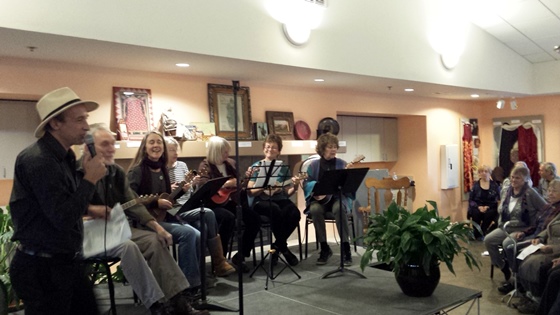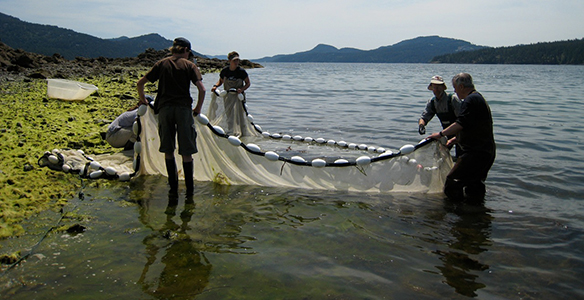||| FROM RUSSEL BARSH for KWIAHT |||
Road washouts last month gave a clear signal to islanders: an increasingly stormy climate threatens critical infrastructure such as roads, power and communications lines, and supplies of potable water. San Juan County urgently needs to act now to “harden” its infrastructure against a future of extreme weather events, higher storm tides and widespread flooding.
Whatever the fate of the commitments made at COP26 in Glasgow, no matter how loudly we protest international gridlock over reducing greenhouse emissions, and despite the best efforts of islanders to reduce their own “carbon footprints,” climate change is already happening here in the Salish Sea with enough force to disrupt our daily lives, our jobs and businesses, and our health and safety.
We do not need to establish boards and commissions to tell us what to do. NOAA, the EPA, and other scientifically-informed national agencies have been funding strategic research and engineering advice since the 1990s, and many communities across the country have been implementing federally funded climate-resilience plans that go beyond mere talk. Actions include relocating roads and utilities as well as using landscaping and habitat construction to help contain riparian and coastal flooding.
Four kinds of extreme weather events must be addressed in rebuilding our infrastructure: heat waves (including spikes in sea temperatures); extended summer droughts that are exacerbated by heat waves; extreme precipitation events like what we experienced this fall, resulting in destructive flooding as well as reduced infiltration to aquifers and increased turbidity and contamination of surface waters; and of particular concern for our islands, windier weather that downs power lines and causes tidal surges and coastal flooding, eroding coastal roads and utility corridors. Rising seas and reduced recharge rates for aquifers will worsen one of the islands’ most serious health and economic bottlenecks: potable water. Stormier winters will also pose challenges for the engineering of substitutes for groundwater including desalinization and rain catchment.
San Juan County was already vulnerable to these changes before the Covid-19 pandemic that has led to a sharp increase in our resident population, and thus in the local demand for electricity, communications bandwidth, and potable water. “Covid refugees” are moving us just a little bit faster towards a future in which islanders may become “climate refugees” due to frequent service disruptions that do not simply mean ferry cancellations, but also more frequent road washouts, blackouts, well failures, and shortages of fuel and food—not to mention rising costs of maintaining and insuring homes.
A rational county government would be busily working on relocating arterial roads and utility corridors, securely burying exposed power and communication lines, promoting distributed power generation and rain catchment engineered for future weather conditions, and investing in up-to-date, environmentally friendly technologies for defending shorelines where businesses and homes are at risk, such as habitat-building with sediments, plants, and shellfish beds rather than concrete, rocks and gravel.
As the islands look for climate resilient solutions, it will be critical to be informed by science and scientists that have specific knowledge of island conditions and how they have changed, with human intervention, for millennia. Sometimes the “obvious” or most talked-about fix is inapplicable to our local ecology, or is simply unsupported by empirical research. One example is managing wildfire.
Droughty summers have already resulted in an elevated risk of wildfire, and this risk will grow as island summers grow warmer and drier, as well as windier. Preemptive controlled burning is a poor substitute for clearing by hand (or with goats) and landscaping with firebreaks and fire-resistant plant species. The irony of burning woodlands and releasing considerable quantities of stored carbon into the atmosphere as a way of addressing climate change seems to have been lost on the islands’ public land managers. As U.S. Forest Service scientists have concluded, fire has not been a routine source of disturbance in Salish
Sea ecosystems for several thousand years—and indigenous islanders did not burn down the forests on which they relied for cedar lumber, and fuel to warm their plank houses and preserve their fish.
It is also imperative that the islands recognize and accept the requisite scale of an effective response to the current rate of climate change. This cannot be done on the cheap. Nor can it be delayed repeatedly, awaiting some future Public Works plan. An example is the Doe Bay road washout that was, in fact, the second time that the road bed was recently repaired where Doe Bay creek runs beneath Point Lawrence Road. Each time, the too-small perched culvert was replaced with a too-small perched culvert, despite the fact that the creek can accumulate enough force to make a short bridge span the most durable solution—not to mention the value of a bridge to the native Cutthroat Trout in that watershed, which I helped identify fifteen years ago. Yes, a bridge will cost more; and it will work better, for longer.
There is federal infrastructure money in the pipeline, some of it tagged for climate adaptation programs. In addition, San Juan County may want to consider that fact that the hot housing market stimulated last year by “Covid refugees” has reportedly added nearly a billion dollars to our property-tax base. Would it be too provocative to suggest that this added value be taxed for funds to keep our roads open, and our power and communications systems running, as we face a stormier future climate?









Well said! We can agree to disagree about some of the details but I don’t see how anyone can disagree that we need to prioritize investment of county resources in preparing for future environmental conditions. The road department in particular still thinks in 1950’s terms and we need 21st century thinking guiding that department. The as-cheap-as-possible design and construction of most of our county roads has been made painfully evident by the recent flooding. What happens when (not if) we get a sizable earthquake? No chain is stronger than it’s weakest link and we have a lot of weak links in the road system on Orcas.
If we are serious about increasing climate resiliency in San Juan County, investments in basic infrastructure must be done BEFORE things fail, not after. We have taxed real estate transactions for Land Bank acquisitions and Affordable housing, both worthy causes, but shouldn’t we be taking care of improving basic infrastructure as well? Many communities charge developers a hefty ‘services’ fee for every additional lot developed. It seems fair to me that new residents should pay their share of the cost of existing infrastructure. Long time residents have been paying for that infrastructure through our property taxes for many decades, new construction should have to ‘buy-in’ to the existing infrastructure and critically, that money must be dedicated to infrastructure, not general funds.
Thank you Russel!
Dear Russell, we’re on it, but we are limited by state law on revenue collection year over year. You heard that right, revenue increase, not percentage increase. We do currently have an extremely low roads levy, as in among the lowest in the state. A road levy lid lift would be possible by a vote of the people. Meanwhile, Managed Retreat roads and drainage projects are on our list of legislative priorities for state and federal funding. You are correct that if at all possible we should have shovel ready projects on the shelf, so design money is explicitly called out in that ask. The County Engineer and the Director of Environmental Stewardship both have a wish list of infrastructure projects we will bite at as local money and grants funding allow. I share your wish to behave as rationally and equitably as possible in the face of reality.
What exactly is the number of people who have become full time residents on Orcas as Covid refugees? Wat is the new full time population? How many more kwh or powere were used and how many more gallons of water on a month over month basis for the last 24 months? Is this data available?
All the comments about the need for climate adaptation are spot-on. “Managed Retreat roads”, that Cindy mentions, should include new roads along both the northeast and the northwest shore to outlying Doe Bay and Deer Harbor. These roads used to to be there in primitive form, but unfortunately were abandoned through lack of foresight. And bridges, not culverts, should be used both for flood-proofing and salmon restoration.
Since we’re talking about “carbon footprint” climate change, let’s also talk about the elephant in the room: driving internal combustion behemoth vehicles for routine trips to town. Sure, there are more electric cars, but where are the available charging stations? And with the new available electric bicycles that make riding our Orcas hills easy, where are the safe bike lanes and bike paths to encourage riding them?
For once I agree with Dan. Transportation is the greatest remaining (fossil) energy gobbler in the county and state. We should be doing everything we can, financial constraints allowing, to address this turkey before it consumes us.
As we pour all this energy and money into protecting development and upgrading infrastructure, let’s make sure we are considering the larger question of how much is too much. How far should we really go in building on these fragile islands, especially in areas prone to landslides and flooding? How far should we go in crowding out all the non-human species? When is it time to recognize that there’s a limit to how safe, comfortable, and convenient we can and should make it for the people here, and acknowledge that living here on these remote islands inherently involves taking risks to comfort and safety and convenience? Is it sensible for this large of a human population who depend entirely on cars and trucks to live on small islands where the only ways off the islands are so limited? Is it sensible to destroy even more of all the other species who live here and use the limited land to build more roads? The climate impact of transportation is a lot more than just vehicle emissions.
I don’t claim have the best answers, but think we need to ask bigger questions and invite more creative thinking. For example, maybe it makes sense to organize a fleet of “Retreat Boats” to transport people when a road is washed out, rather than build new roads. Maybe that doesn’t make sense or isn’t the best solution.
I think we need to seriously consider how we can each contain the stormwater runoff from the impervious surfaces we have added to our own private property, and the increased runoff that results from removal of vegetation such as trees, and keep that extra runoff on the property instead of letting it flood our neighbors or adding to impact on both infrastructure and natural waters and the beings who live there.
Surely there’s some other possible future here than following the example of colonialism that sees wild beings, land, and water as having value only if we can control, use and exploit them, and paving and developing every bit of land that isn’t already in conservation as if no species but humans counts. With the current trend, that appears to be exactly where we are headed.